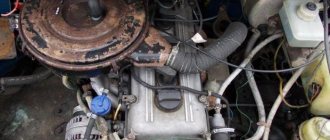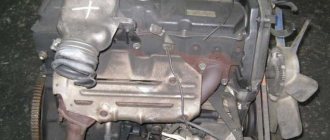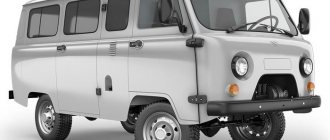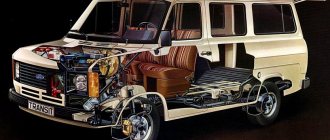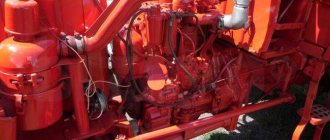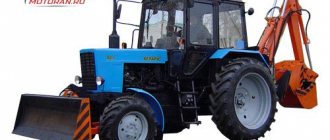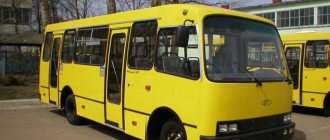Description of the YaMZ-5344 engine
The 5344th model of the YaMZ engine was created for installation on the PAZ-32053 (including the entire model range of this family). Has two modifications:
- “5344-10” is intended for “mid-range” GAZ-3308/9;
- “53442” - for GAZ-3308 models marked with increased cross-country ability.
Available in two configurations for mounting an air conditioning compressor (for the above-mentioned “families” GAZ and PAZ).
The basis for the design of the YaMZ-5344 is the 5340th model; the difference lies only in the regulation of the fuel “supply”, since the settings of the electrical control unit differ. Thanks to the innovative exhaust recirculation system, the engine is brought into compliance with Euro-4 eco-standards. The average working life of the unit is 700 thousand kilometers. The cost on the official website of the manufacturing plant is 560 thousand rubles.
Engine YaMZ 5344
Manual
Errors in operating the engine will significantly shorten its service life. Therefore, it is worth paying attention to some features of its operation:
- after warming up to 80-100 C, long-term operation at minimum idle speed is prohibited, as is full load of the unit without warming up;
- the coolant should not heat up above 80-100 C (it is permissible to exceed the temperature by 5 C for no more than 10 minutes);
- To ensure that the turbocharging system does not fail, before turning off the engine, it is necessary to run for 2-3 minutes at minimum idle speed;
- after a long period of inactivity or changing fuel injection pump filters, the fuel supply system must be pumped with fuel.
- You cannot use coolers, lubricants, filters that are not prescribed by YaMZ-5344.
Be sure to read: Repair dimensions of crankshafts
Applicable:
- oil filter W11102 ;
- base coolant – GlycoShell (or concentrate);
- base engine oil – Shell Rimula R4L (SAE 15W-40, API CJ-4, CI-4, CH-4, CG-4, CF-4, CF);
- base diesel fuel – type II or III according to GOST R52368-2005 with a sulfur content of no more than 50 mg/kg.
It is acceptable to use analogues, the list of which is shown in the “Operation Manual” included with the unit.
Since the engine is equipped with the “brains” of the ECU, in the event of overheating, excessive speed, loss of oil pressure and other emergency situations, it stops working automatically.
When running in a new unit, avoid full load or driving at high speeds.
Model history
Throughout the first decade of the 2000s, every year it became more and more obvious that the huge commercial success of Gazelle cars in the Russian and CIS markets would not last forever. Gazelle has plenty of competitors in the field of light-duty business vehicles, and they all have something to interest a potential buyer.
The price factor no longer always became the most important and determining factor when purchasing, especially since the car lending system has developed extraordinary over the years, and loans began to be issued to almost “everyone.” And buyers have become more picky, able to compare and contrast, and are ready to overpay for comfort and reliability in operation, and increased profitability. Therefore, “Gazelle” gradually lost its position, being forced out of the market by more expensive, but also more modern imported “classmates”.
A “response move” in this situation could only be the launch of mass production of a new car, corresponding in quality to modern “classmates” (such as Mercedes Sprinter, Peugeot Boxer, Volkswagen Crafter, Ford Transit, Fiat Ducato ", etc.) But at the same time having a more attractive price!
Meanwhile, the new family may not have reached the assembly line, which has happened more than once with other developments by domestic designers. The following course of action was considered: not to go into the business of creating your own model, which requires enormous capital investments and hassle, but simply assemble the previous generation Mercedes Sprinter at GAZ facilities.
However, even with the highest level of localization, the German light-duty vehicle turned out to be by no means cheap, and in no way falls into the rank of a “budget” car. Domestic consumers, for the most part, should be given a simple frame car (the Sprinter has a monocoque body), which can be overloaded regularly and without serious consequences, and all sorts of minor repairs can be carried out, as they say, “on the knee”, without taking a long break from workflow.
To prepare for the release of the new model, the Gorky Automobile Plant carried out a large-scale modernization of production. The total investment in the Gazelle Next project amounted to almost nine billion rubles.
To produce the new model of the all-metal GAZelle Next van, new automated welding and stamping complexes were created at the Gorky Automobile Plant sites, the painting production and assembly line were modernized.
The automated stamping line is equipped with the latest multifunctional six-axis robots of the latest generation and presses with imported stamping equipment specially made for the project. The line produces large parts, including side panels, bases, sliding and swing doors.
The new welding line allows automatic production of bodies of various modifications. Modern Fanuc robots with a lifting capacity of up to 700 kg are installed in the welding areas of the sidewalls, base, body and door assembly-welding. Each robot, independently changing equipment, is capable of performing operations such as transporting parts, welding, flanging, and applying adhesives and sealants. The welding line also includes new overhead push conveyor routes and automated components supply systems.
Following the basic flatbed version and the universal chassis, other “Gazelle Next” followed: in March 2014, serial production of a truck with a seven-seat double cabin and a bus with a frame-panel body in urban and intercity versions began; In April 2016, sales of all-metal Gazelle Next vans started.
The substantial investments began to pay off: new cars are selling well on the domestic market: more than fifteen thousand buyers choose them every year. The Gazelle Next assembly production for the needs of the local market was also organized in Turkey.
Technical characteristics of YaMZ-5344
“5344” represents a line of 4-cylinder L-shaped “engines” from YaMZ. Sold without a gearbox: you can use a gearbox from any manufacturer if it meets SAE3 standards (like the clutch). General technical characteristics of the YaMZ-5344 engine:
- unit weight – 480 kg (without refueling);
- power – at least 136 hp;
- torque limit – no less than 421 Nm;
- number of measures – 4;
- fuel consumption - about 15.5-16 liters per 100 km;
- total cylinder volume – 4.43 l;
- compression ratio - 17.5 units;
- mixture formation occurs through direct injection;
- injection pressure provided by the fuel system (Common Rail System) – 180 MPa;
- Injection pump – 3-plunger, block (brand “BOSCH”);
- electrical control system – microprocessor EDC7 UC31 (models “0 281 020 111”) from BOSCH (covers oil pressure, charge air, coolant temperature, camshaft and crankshaft rotation sensors).
The temperature range for which the engine is designed is +/– 50 C.
The YaMZ engine requires careful operation
Cabin "Gazelle Next"
The doorway area of the Gazelle Next cabin is 23 percent larger than in a regular Gazelle. The interior has become taller and overall there is more space. The driver's seat "Isringhausen" is imported from Germany and provides lumbar support, as well as adjustment in all directions. It is possible to adjust the height of the seat belt fastening.
The plastic of the cabin panels is still inexpensive and rigid. However, it received a new shape and texture. The instrument panel includes 2 dials and an on-board computer display. The ergonomics of the interior are pleasing: there are many useful shelves and pockets, there are 2 cup holders and 2 bottle holders, there is a coat hook on the wall, and for an additional fee you can install a shelf for a radio station under the ceiling. Buttons and other control devices operate smoothly and look good.
An adjustable armrest has appeared between the seats, which does not interfere with changing gears at all. The left (door) armrest runs the entire width of the door; on the passenger door the armrest is noticeably shorter. By the way, GAZ specialists implemented this innovation “at the request of the workers,” who complained about the insufficient length of the cabin, which made it difficult to stretch out while lying at full height.
The Gazelle Next cabin is also distinguished by its safe design, due to the inclusion in the configuration of special power elements that have specified deformation points. In an accident, they take most of the impact. Seat belts received pretensioning devices.
In the double version, there is an additional swing door on the right side to facilitate the boarding and disembarking of passengers from the “gallery”. The basic package additionally includes a pre-heater, a heater, an increased power battery, a heated fine fuel filter and an additional 12V socket in the rear of the cabin.
Unit design
YaMZ-5344 is made of cast iron, the crankshaft is steel. The cylinders form a monolithic block with a common head with an intake air manifold. The design of the main subsystems is as follows:
- The ShPG consists of a one-piece piston, 3 piston rings, a steel pin, an I-section connecting rod, liners and an injector. The nozzle is located on the lower head of the connecting rod.
- Cooling. In the “front” part there are cooling units that operate from a belt drive. The cooling system is liquid; a water pump, a centrifugal pump and an axial fan with a clutch are mounted in the service module.
- Fuel filtration is carried out by two fuel filters (coarse and fine) produced by MANN+HUMMEL.
- The gas distribution device is overhead valve, the camshaft is located at the bottom.
- Lubrication is carried out by sucking oil from the crankcase with an oil pump and feeding it into the system through a liquid-oil heat exchanger and filter. The pump can only be accessed by first removing the flywheel housing.
- Fuel injection is coordinated by the ECU. The nozzle is a closed type. Includes a sprayer, hydraulically controlled needle lift, and an electromagnetic fuel supply valve.
Be sure to read: Steering MTZ 82
The unit is equipped with a turbocharger that uses exhaust force to produce boost.
Gazelle Next parameters, standard base
- length – 5.630 m;
- width – 2.068 m;
- height – 2.137 m;
- wheelbase - 3.145 m;
- turning radius – 5.6 m;
- ground clearance - 170 mm;
- front track - 1,750 m;
- rear track – 1,560 m;
- curb weight – 2,060 t;
- load capacity – 1,440 t;
- total weight – 3.5 t;
- maximum speed – 134 km/h.
- length – 6.709 m;
- width – 2.068 m;
- height – 2.137 m;
- wheelbase - 3.745 m;
- turning radius – 6.5 m;
- ground clearance - 170 mm;
- front track - 1,750 m;
- rear track – 1,560 m;
- curb weight – 2,230 t;
- load capacity – 1,270 t;
- total weight – 3.5 t;
- maximum speed – 132 km/h.
The loading height is 95 centimeters. internal dimensions of the cargo platform: length – 3090 mm (standard); 4168 mm (extended version) – with a 3-seater cabin; length – 2339 mm (standard); 3090 (long version). Overhang angle (with load): front – 22 degrees; rear - 16 degrees. The maximum volume overcome is 26 degrees.
Dimensions of the minibus in millimeters (length x width x height): 6080x2530x2720. Wheelbase - 3745 mm. Gross weight - 4252-4292 kg.
Price of the Gazelle Next car
The price for the onboard version of the Gazelle Next starts at 995,000 rubles (3-seater cabin, standard base, gasoline); diesel - from 1,155,000 rubles; gas – from 1,055,000 rubles.
The price of the all-metal Gazelle Next van starts at 1,160,000 rubles (3-seater cab, standard base, gasoline); diesel - from 1,300,000 rubles.
The Gazelle Next bus based on an all-metal van can be purchased at a price of 1,400,000 rubles (gasoline); from 1,540,000 rubles (diesel); from 1,440,000 rubles (gas).
The Gazelle Next Cityline bus costs from 1,590,000 rubles (diesel); from 1,520,000 rubles (gas).
Despite its recent presence on the market, Gazelle Next is already widespread in the vast majority of regions of Russia and is represented on the secondary car market. They ask for used cars from 650,000 rubles (flatbed, tilt).

